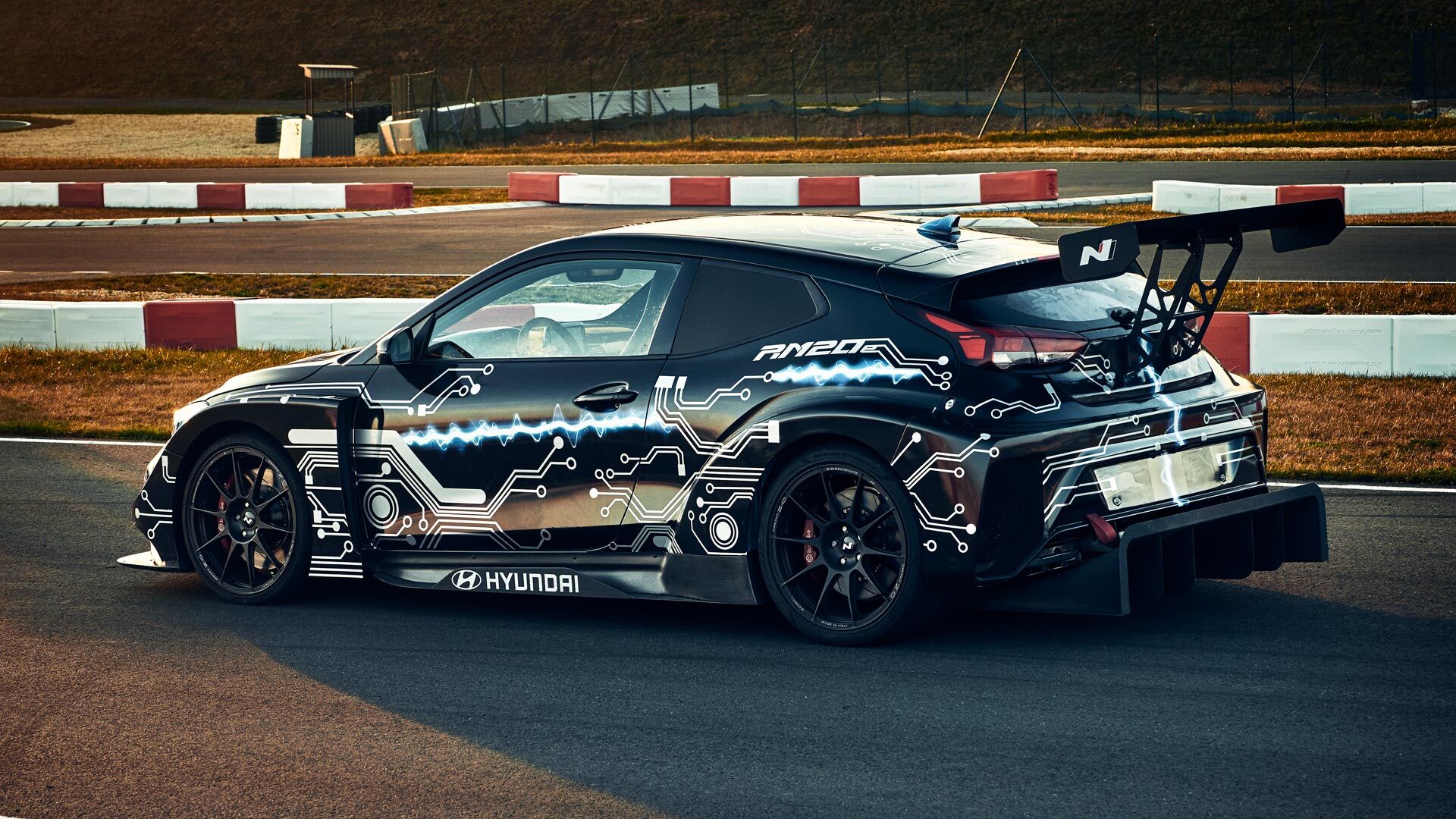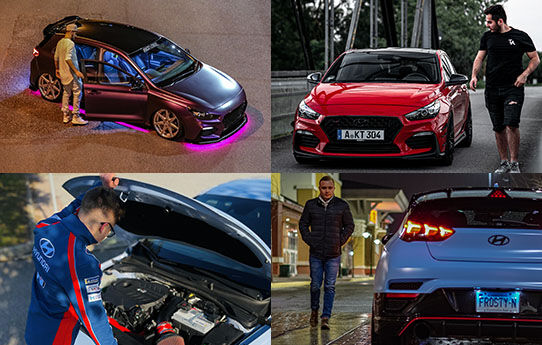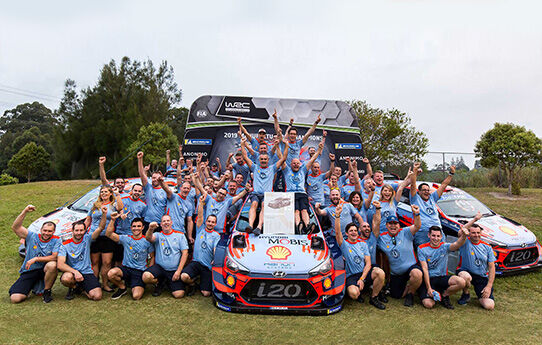The Future of High-Performance N
Electrification : RM20e
29 NOV 2021
By Sujin Lee
Here are the details of the RM20e that show us the future of the N, a very important part of Hyundai's high-performance philosophy.
Learn more about RM20e
29 NOV 2021
By Sujin Lee

Last year, when the world was put on lockdown due to COVID-19, Hyundai Motor Company drew attention by introducing the RM20e, a high-performance electric vehicle prototype. The RM20e is not for mass production, nor is it a mere concept for futuristic design or brand image. It is an integral part of the RM project, which serves as a testbed to collect data and verify advanced technologies.
The RM20e, unveiled last year, is the fifth model of the RM project. Though it may look similar to the RM19 revealed in 2019, it has a pure electric drivetrain and signifies a big step towards the era of eco-friendly high-performance cars.
How the RM20e was developed
Unlike the past RM14, RM15, and RM16 which were developed from a production model, Veloster, RM19 and RM20e are based on racing cars ─ Veloster N TCR & ETCR. Let's take a look at the R&D process of how motorsports technology is directly passed on to the 'Rolling Lab.' The process requires the collaboration among Hyundai Kia Namyang R&D Center, Hyundai Motor Europe Technical Center (HMETC), and Hyundai Motorsport GmbH (HMSG). The three counterparts, all working on different sides of the planet, have been producing high-quality outcomes based on experience from WRC and WTCR race cars development despite the pandemic.
Learn more about Project RM (RM14, RM15, RM16)

The RM19 and RM20e share the same heritage.
RM19 and RM20e were conceived together from the planning stage, and the following step-by-step R&D system was introduced for precision. In the first stage, the foundation planning of concept development and specifications for the second and third stages take place. The total time span for the entire R&D is also calculated in this stage. Such planning is crucial in terms of the efficiency of R&D in each sector.

RM19 and RM20e, the latest works of the RM project, were developed through the automaker's unique step-by-step R&D system.
Learn more about RM19
In the second stage, a prototype based on a designated race car is produced. Prototypes #1 and #2 were first produced based on Veloster N TCR and Veloster N ETCR. In this process, the passenger seats were re-installed, and the race car parts were modified to suit a regular passenger car. These included the rack-mounted motor-driven power steering (R-MDPS) and partial roll cages. The suspension was also changed to MacPherson struts in the front and double wishbones in the rear. As an exception, the engine and ABS brakes are made up of race car parts to test the performance to the limit.
In the third stage, prototype #3 is produced with an upgraded driver convenience and performance based on prototypes # 1 and # 2. In this process, the RM19 #3 became even closer to a mass-produced car; unlike the past RM19 #1 and #2, the TCR powertrain was replaced with a newly developed 2.3L turbo engine and 8-speed wet DCT. In addition, the aerodynamic performance was refined by installing a front-wheel deflector and a top-mounted rear wing. By doing so, the undercover was refined. In other words, compared to the first two prototypes, which focused on verifying new technologies that are practical, a lot of effort was put on the third prototype to make sure it is feasible for mass production.

The difference between the latest RM20e and the Veloster N ETCR - Race car VS High-performance prototype
RM20e, the 5th of the RM project, is an experimental model that pilots the direction of 'Hyundai N Performance' in the EV era. It was inspired by the Veloster N ETCR, which was unveiled at the 2019 Frankfurt Motor Show. As is well known, the Veloster N ETCR is a race car developed for 'PURE ETCR', the all-electric touring car series that commenced this year.
Learn more about Veloster N ETCR

The RM20e is similar to the Veloster N ETCR in terms of design and powertrain configuration. This is because it is based on the RM19 which is developed from Veloster N TCR, an origin of Veloster N ETCR. By inheriting the aerodynamics of RM19 and powertrain of Veloster N ETCR, the team could efficiently develop RM20e to clearly function as both the 'Rolling Lab' and an electric racing car. Passenger seats and a brake booster were added, while steering responsiveness was enhanced with R-MDPS. In addition, a speaker was installed to create a virtual internal combustion engine sound. A suspension that combines a MacPherson strut in the front and a double-wishbone in the rear with a damper with adjustable damping force is also a unique part of the RM20e. Unlike ETCR race cars, which have power restrictions (continuous 410 HP average, peak 680 HP), RM20e does not have to abide by any regulation.

This is why the RM20e is the most powerful model in the history of the RM project. A four-motor configuration with two 148kW motors mounted on the left and right rear wheels has a system output of 800 horsepower. In addition, a powerful system torque of 960 Nm drives the rear wheels. The brake system is also equipped with Bosch Racing ABS for robust power. To cater to driving on normal roads, the performance was refined so that the rear-wheel drive can handle the maximum output exceeding 800 horsepower. It should be noted that the e-ASD+ for high-performance electric vehicles is very sophisticated, too. E-ASD+ provides exhilarating sounds that attract the driver, such as a retro engine booming feeling at idle, low speed and a strong roaring sound of Formula E vehicle at high speed driving through the speaker.
The RM20e's 60kWh cylindrical lithium-ion battery provides a cooling effect through liquid immersion. Thanks to the 800V high-voltage system, it can be charged up to 80% in about a mere 30 minutes. Above all, it realizes excellent driving stability and agile handling despite the heavy battery placed at the bottom.

Imagine the future of high-performance N electrification
As the 'Rolling Lab' is to test, develop high-performance related technologies and showcase Hyundai's potential, the technology of the RM20e can be applied in future high-performance electrified models of Hyundai. Without a doubt, gathering from the RM project and motorsports will continue into the electric vehicle era.
Click the image of RM20e below to learn more about 'Rolling Lab'
The RM20e is an electric supercar that embodies both the reality and possibilities of the era of electrification.
We can predict new technologies to be applied in the future by looking into the RM20e. For example, the RM20e is equipped with e-ASD+, a virtual engine sound technology dedicated to high-performance electric vehicles, and technologies that arouse emotional bonding between the driver and the car. Likewise, it may be possible to see Hyundai's high-performance electric car with the iconic 'popcorn sound' of the current internal combustion engine N models.
In addition, a dual-motor system can achieve near-perfect cornering performance unlike that of an internal combustion engine vehicle, which has independent traction control. Moreover, based on the know-hows from IONIQ, specifically the battery output map that depends on the temperature, directions for future technology development such as cooling control optimization, battery pre-conditioning based on drive mode can be built.
Unlike the existing RM projects, which was used as a testbed for mass-production vehicles, the RM20e itself opens up unseen possibilities of mass production. This is a story that has the potential to appear in the market as a true Hyundai super sports car beyond a 'Rolling Lab.'
By Sujin Lee, automobile critic Excited about the 1991 establishment of the first domestic auto mania magazine 〈Car Vision〉, I sent a series of long letters there that led to an unexpected hire. 27 years have passed since then, the years of plowing through the writing struggles of an auto journalist. After becoming an editor for 〈Car Vision〉, I came to my current position as the Editor-in-Chief for 〈Car Life〉. My recent interests include cutting-edge techs like electric cars, connected cars, and autonomous driving, but the ‘otaku’ in me doesn’t want internal combustion engines to disappear either.





